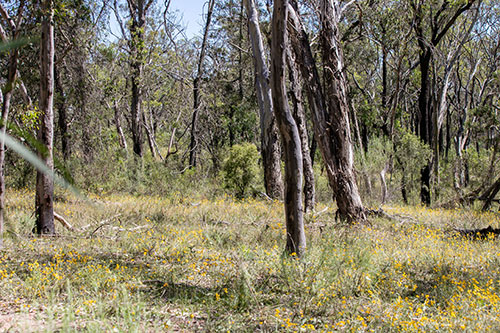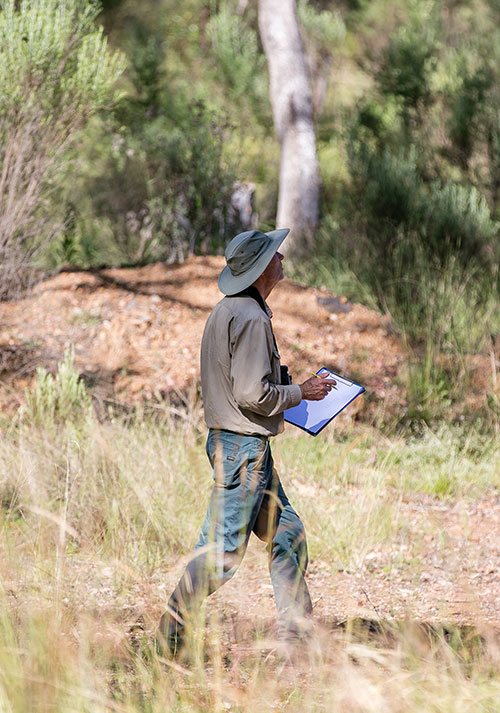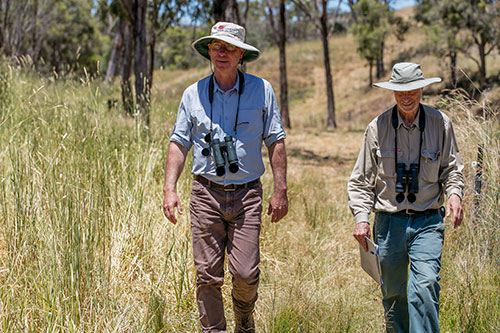In search of the Regent honeyeater
Text and images by Mel Jensen.
As bird ecologist Steve Debus moves through the bush on a bird survey, he is almost silent, with clipboard and pen in hand, his focus intently on what he can hear and see. Most of the time Steve will hear birds before he sees them and identifies them immediately.
“Little lorikeets,” he says, “they’re threatened” followed by “I can hear some Brown headed honeyeaters too.”
We’re on the lookout for the critically endangered Regent honeyeater (Anthochaera phrygia) east of Barraba on the North West Slopes of NSW, one of the last bastions of this majestic bird. Sadly, we don’t find any. Really, it’s not surprising, with an estimated 250 to 350 left in the wild, the chances were slim.
Steve is undertaking the survey for North West Local Land Services (North West LLS), who have been supporting work to help protect the honeyeaters around Barraba since 2016.
What began as a project to see if the birds were living in the region, has extended to now working with landholders supporting habitat management on private land. This bird is becoming so rare that young males are losing their song, as they lack adult males to mimic.

Barraba bushlands.
A species in decline
Sadly, halfway through the survey of several sites and we haven’t seen or heard any. In fact it’s been five years since Steve has recorded any nesting pairs, save one, but they didn’t hang around more than one season.
“White-plumed honeyeaters had been recycling some of the regents’ nest material for their own nest 10 metres away,” Steve says.
“There is no way of knowing what caused the failure, but there are the usual suspects in that patch such as predatory birds and sugar gliders.”
The story of the decline of the Regent honeyeater is a familiar one: habitat loss and fragmentation and competition from other species who have moved in as a result and which also predate or push out birds such as honeyeaters and other rare or endangered species.
“Farming areas, in particular the loss of box-ironbark forests, and gardens with the introduced plants provide food sources all year round and can lend themselves to overpopulation of birds like currawongs and noisy miners, along with introduced pest birds like starlings and Indian mynas.
“Currawongs eat the young honeyeaters and larger than natural populations of noisy miners drive the regents from their territories.
“Lack of suitable nesting sites disrupts the regent’s ability to nest in loose congregations of several pairs, where they were able to protect their eggs and young from other birds.”
It’s also how they would learn their songs. Without the ability to call a mate, the species is in trouble and the problem isn’t just a lack of male role models.
“They found in captive-bred regents at Taronga Zoo as part of a translocation program, that the males were losing their ability to call and were picking up calls of other birds at the zoo,” Steve said.
“The problem is the period of time the young birds are open to learning the call is a very narrow window, which can be so easily disrupted.”
The Regent honeyeater was once common around Bingara, Barraba, Tamworth and further west towards the Pilliga, however the recent surveys paint a bleak picture.
North West LLS’s Craig Pullman says this continuing trend over recent times seems to support research that shows these birds are now heading for extinction within the next 10 years.
“If the remaining birds do not make it, the Regent honeyeater will be the second bird extinction on the Australian mainland since European colonisation, following the Paradise parrot,” Craig said.
“Through our projects working with landholders and our partners BirdLife Australia, Landcare, and Ozfish Unlimited, we have increased native vegetation for woodland birds and supported graziers to consider these habitats in their land management.
“Native bushland that provides food and nesting sites is critical to the survival and dispersal of Regent honeyeaters, including those released from captive breeding programs.
“Our regeneration project to plant trees doesn’t just target Regent honeyeaters but Swift parrots and other threatened woodland birds.
“Mugga ironbark, yellow box, white box, and mistletoe on river oak are key nectar sources for a range of threatened woodland birds and in urban gardens flowering shrubs like bottlebrush and grevillea are preferred.
“We also must acknowledge the combined efforts of project participants such as the Barraba community, who are essential to providing food and habitat for the future of woodland birds in the region.”

Dr Steve Debus surveying woodland birds near Barraba NSW.
A passion for birds
For Steve, work as an ecologist can be as exhilarating and uplifting as it can be worrying. He has two projects at the moment, with North West LLS and the Regent honeyeaters, and Northern Tablelands LLS on three raptors: the Square-tailed kite, White-bellied sea-eagle and Little eagle.
He says a highlight was finally encountering Swift parrots and nest-building Regent honeyeaters during a survey after negative surveys since starting in 2016.
“I’ve only seen these once each in five years of quarterly surveys across a dozen sites, so it was special and gave us hope.”
“But over the years I’ve seen fewer Regent honeyeaters at the monitoring sites and other places I go to record other bird species.”
It’s the passion of people like Steve that birds like the Regent honeyeater depend on now.
It’s a passion he’s had since primary school and has grown to birds of prey (raptors) and owls as his primary interest and threatened raptors as his major work focus.
It was seeing raptors being ‘managed’ on farms that cemented an aim to study and protect these birds.
“After exposure in childhood to persecution of raptors on farms I studied biology in high school, then biology/ecology at university.
“I participated in a citizen-science project on recording birds (the first national bird atlas), and pursued zoology and ecology at postgraduate level at the University of New England, where I have an honorary position now.
“I’ve studied a graduate diploma (project on eagles), Masters (owls) and my PhD thesis was on declining woodland songbirds.
“These days I work as a consultant mainly doing fauna surveys, and as a research associate in zoology at UNE.”
A normal day’s work could see him in the bush finding and monitoring nests of threatened raptors on the Northern Tablelands project or surveying for Swift parrots, Regent honeyeaters and other woodland birds on the North-West Slopes around Barraba, and occasionally up near Boggabilla as well.
“The best part of the Tablelands project is annually adding to the growing number of known raptor nests of the three target species and seeing them successfully raise young.
“Then there’s nothing like the feeling of finding the Swift parrots and Regent honeyeaters, or other threatened woodland birds, knowing that there still may be hope.
“Working with and having positive engagement with interested and conservation-minded landholders is a highlight of my work.”
“Finding spotted harriers nesting near Armidale, or seeing a little eagle make the fastest vertical dive I’ve seen that species make, headlong at a rabbit with an audible whack as it struck are two of the most amazing things I’ve witnessed.”

Project Officer Craig Pullman and Ecologist Dr Steve Debus.
What can we do?
As we wind up the surveys for the day, I’m sorry we haven’t seen any regents, but inspired by the incredible bushland and Steve and Craig’s passion. I’m enthusiastic about trying to do my bit to save these endangered birds. But do I have to be an ecologist to help preserve and protect wildlife?
“Definitely not,” Steve says.
“Just being outdoors with your eyes and ears open for birds, then sharing what you see is a great start.
“There’s plenty of opportunity for citizen-science projects or joining a local group.
“We’d love to see people reporting nests and breeding events of target raptor species (Square-tailed kite, White-bellied Sea-eagle and Little eagle) on the Northern Tablelands, and sightings of Regent honeyeaters and Swift parrots in the North West.
“If possible, reports accompanied by photos can help with identification of these birds.”
In backyards, small or large farms, there are many options to help save regents and other threatened woodland birds.
“Restoring native tree cover, even by one tree at a time or creating bird-friendly gardens, reconnecting habitat, rehabilitating creeks and rivers and their bank vegetation, are all projects that can be done in a small or large way.
“As landholders, we need to be protecting habitat remnants, eradicating berry-bearing environmental weeds like African boxthorn, privet or even pepper tree that feed birds like currawongs and avoiding raptor and owl-unfriendly rodent or rabbit poisons.
“Another simple way where possible is to avoid putting barbed wire on fences and leaving mistletoe alone.
“On a large scale, covenanting land of high conservation value is a great way to ensure preservation of biodiversity and our landscapes which support our most fragile species.”
Local Land Services is working with Birdlife Australia and Australian National University on other projects including contributing to national monitoring data and reducing threats in Regent honeyeater habitat.
Healthy Regent honeyeater habitat supports a large range of other woodland bird species many of which are in decline such as Little lorikeet, Turquoise parrot, Speckled warbler and Diamond firetail.
This project is delivered by North West Local Land Services, through funding from the Australian Government’s National Landcare Program.
For more information
Contact Craig Pullman at craig.pullman@lls.nsw.gov.au or call your nearest Local Land Services office on 1300 795 299.